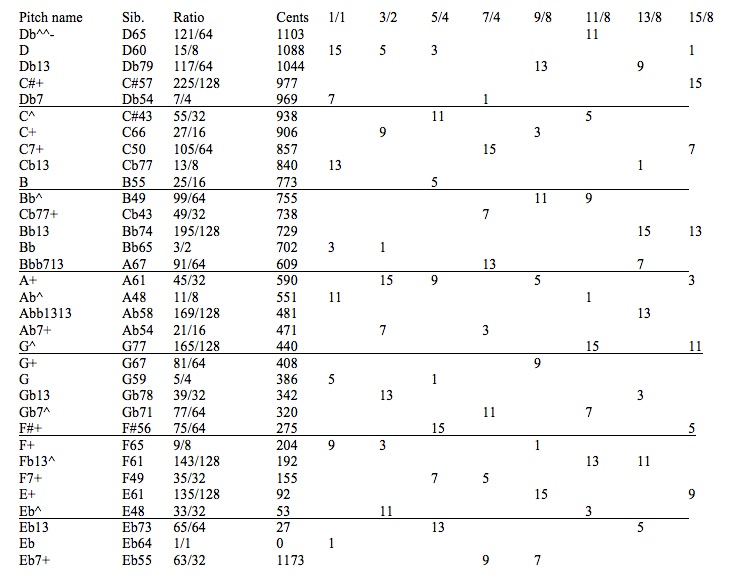I have always said that I've never found two microtonalists who have the same reason for using microtones, or who use the same method for composing with them. This diversity is a blessing. It is also, admittedly, an inconvenience: if we could all agree on some kind of system, some one notation, it would undoubtedly speed up some kind of microtonal performance practice. But since, of course, we will never come to any consensus about what kind we want, and for now I find myself committed to the boundless frontier of unfenced microtonality.
I do, however, have strong and, to me, philosophically and musically compelling reasons for choosing the microtonal path I've taken, and, not being the kind of liberal that Robert Frost described as being "too open-minded to take his own side in a quarrel," I thought, today, that I would propose my own approach to just intonation as a kind of model. It is not unique to me, and to some extent I inherited it from my teacher Ben Johnston, but I think I have pursued it more single-mindedly than he did. I have achieved less than Ben partly because he was such a brilliant conceptualizer, and partly because he did many things, whereas in my work as a microtonalist I have kept trying to do one thing, and to see where it leads. What I did inherit from Ben, and I think it is implicit in his microtonal notation (in which I've been writing for more than three decades now), is a sense that the future of music lies in going back to the early 17th century at the point at which Europe closed off the possibilities of the harmonic series, and in certain respects beginning again from that point. Our common practice harmony is based on what were originally five-limit intervals, particularly the 3/2 perfect fifth, the 5/4 major third, and the 6/5 minor third. By building new triads on members of previous triads we can evolve a large gamut of tones and elicit a wide range of harmonies within a limited pitch space:

I will now put up a progression that expands from triads to seventh chords, linking them via pivot tones in a manner typical of Brahms, though here carried to perhaps an unusual length:

If we tune the sevenths of these chords to the seventh harmonic, we get a vast expansion in the range of intervals available and the subtlety of chromatic nuance. This next chart is the exact same chord progression renotated in Ben Johnston's notation, with seventh harmonics marked by sevens and seventh subharmonics by upside-down sevens:

The numbers tell the distance from C in cents. You can see that the top line offers seven different pitches in the narrow minor third from 814 cents to 1088 cents, with six of those in less than a whole-step: 814, 884, 899, 933, 969, 1003, and 1088. Likewise, the tenor line uses seven pitches in less than a minor third, and aside from the C, the bass line has five pitches within a space smaller than a whole step. And yet this chord progression is built up in a perfectly conventional way found frequently in late Romantic music, only with the tuning limit raised from five to seven. It requires 25 pitches to correctly tune this sequence of ten seven-limit chords.
From the beginning it seemed to me that if we could learn to apprehend relations between these complexly related chords based on the 3rd, 5th, and 7th harmonics, then we must be able to further hear such relations based on higher harmonics. This became my approach to microtonality: that one could climb further up the overtone ladder to the seventh and eleventh harmonics while pivoting between chords in the same way European composers have always done in the triadic system. I have often joked that I became a microtonalist because I liked Max Reger's music but didn't find it chromatic enough. What was crucial for me was to become able to hear these new intervals in my inner ear and compose with them intuitively - I was never content to impose a structural or mathematical system on music that I couldn't feel. And it seemed to me that the way to internalize them was to use them in the same kind of context that I had learned the traditional intervals as a child. I knew how to hear a movement from a tonic to a major submediant (the fifth harmonic), and I thought that with training I could come to hear one triad moving to another based on the eleventh harmonic.
At the same time, microtonality offered me a bridge over which I could glide back and forth between Romanticism and minimalism and bypass modernism altogether. Why bypass modernism? Because I had begun to feel trapped in an aesthetic based equally on endless novelty and ascetic prohibition. I've always thought the composer George Rochberg characterized this accurately: the progressing history of music was always inclusive and cumulative, each era receiving what was valuable from the previous one and building on it - until the mid-20th century, in which composers decided to exclude and prohibit aspects of the musical practice associated with the past. It became forbidden to do all the wonderful things in music that we already knew how to do, and a composer constantly walked on eggshells trying to avoid reminding a listener of any previous music. Rochberg felt that this negative new attitude was a collective neurosis, and a sure road map to oblivion, that a prohibitionary approach to composing would inevitably become a dessicated practice that would blow away with the first wind. By contrast, to add new harmonics to the musical practice we already had allowed me to bring the past along with me, and I felt that the more my compositional technique was rooted in the past, the more securely it would stand in the future. I always liked Partch's statement, "Let no year pass that I do not step one significant century backward."
And so I moved up to the eleventh harmonic. I've always had more affinity for Renaissance counterpoint than Baroque counterpoint, in addition to which I felt that until we learn how this new harmonic world operates a Renaissance approach was the safer route. And so my criteria were relentlessly contrapuntal, based in voice-leading criteria rather than root movement. I'm going to play an excerpt from my 2005 chamber piece The Day Revisited, in which I spiraled through a collection of eight harmonic series'. The criterion for ordering them were to base them on some line of counterpoint within the chords ascending through the smallest possible intervals, and within that chord progression I would write melodies fixating within a small, static region. In other words, the chords would gradually ascend, but the melodies would stay as fixed in register as possible, so that the melody note's place in the current harmonic series would keep changing, as happens in good conventional counterpoint. Here the piano plays among eight notes bounded by a small minor third, occasionally leaping upward by a third in the harmony (for some lines I have notated the pitch's distance in cents above the tonic D, to give a more accessible sense of how close the pitches are):
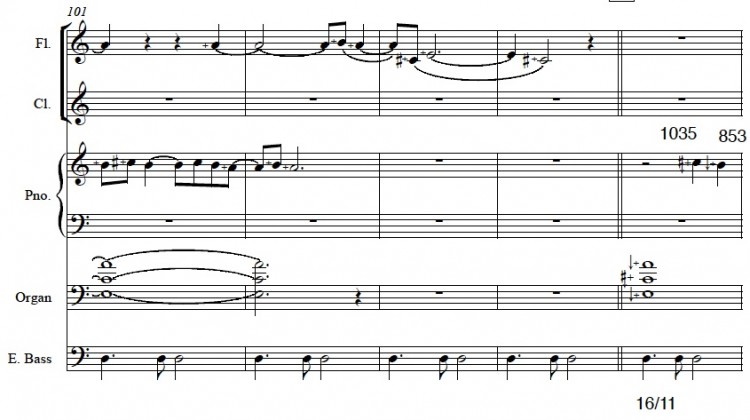
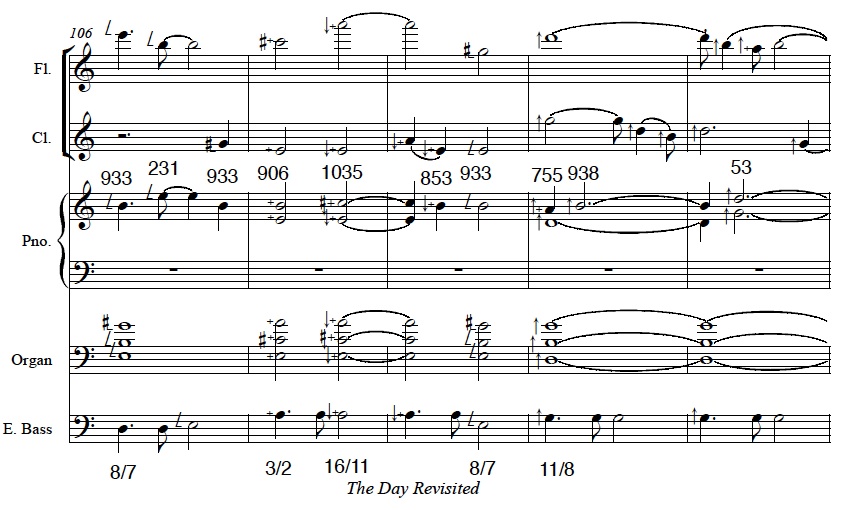
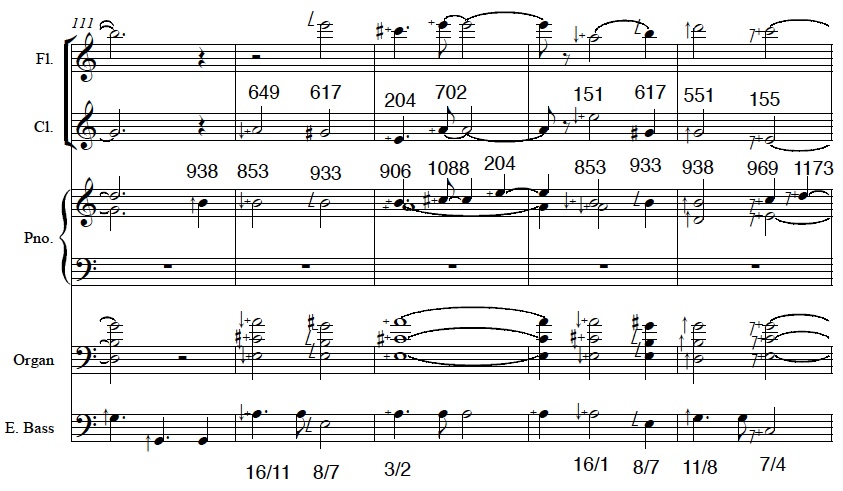
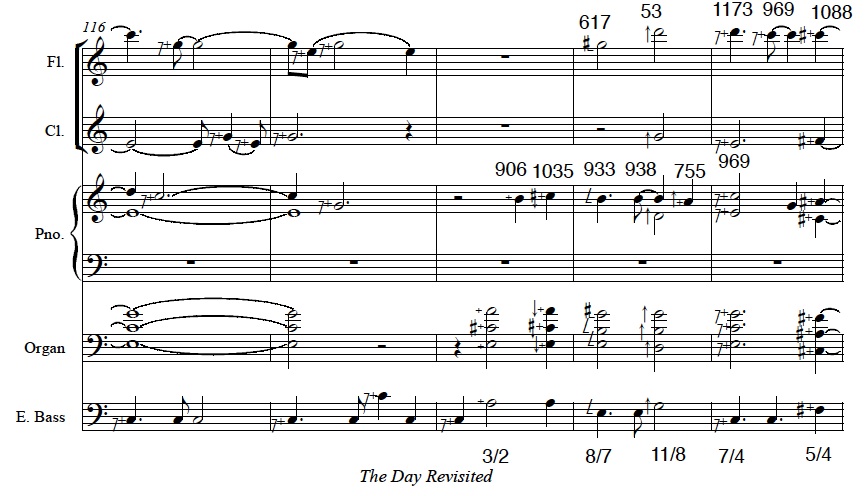
One will note that in this case the triadic and seventh-chord harmonies are fairly conventional in themselves, the exotic element being the contrapuntal voice-leading between chords. I wanted the audience to learn to feel these tiny intervals, to literally go out humming them (in the way that Ives predicted a coming century in which schoolchildren would whistle tunes in quarter-tones); but to be understood, it was crucial that they be harmonically supported - and, at the beginning, by chords which in themselves were already familiar.
From 1984 to 2004, I contented myself with the eleventh harmonic. Part of this was out of allegiance to papa Harry Partch, who had not only gotten along fine but done wonders within eleven-limit tuning. As he wrote in Genesis of a Music, though,
...[T]he reason for resting at the limit of 11 is a purely personal and arbitrary one. When a hungry man has a large table of aromatic and unusual viands spread before him he is unlikely to go tramping along the seashore and in the woods for still other exotic fare. And however skeptical he is of the many warnings regarding the unwholesomeness of his fare... he has no desire to provoke further alarums. [Genesis of a Music, p. 123]The other reason for stopping where Harry and I had stopped was that I had far more trouble learning to hear and anticipate the 13th harmonic than I had the 7th and 11th. But the problem I kept coming across, measure by measure, in The Day Revisited and other pieces was that within any one tonality I could use whole steps from which I could almost always find a pitch in the next chord less than a half-step away - except where I encountered a gap of 267 cents in my scale between the 12th and 14th harmonics:

In addition to Ben Johnston's pitch notation for the 7th and 11th harmonic I have also added some of my own verbal notation to document the kinds of comments I typically made upon encountering this interval in counterpoint.
So I had considerable incentive to fill in that gap with the 13th harmonic, and I started to train my ear by writing a simple piece hammering away at the 13th harmonic over a drone, Triskaidekaphonia of 2005. For this piece I employed a simple scale concept of using all 29 intervals formed by the ratios of the numbers one through 13. This also gave me a range of scales moving from the satisfyingly exotic (a tridecimal tuning of 13/12, 13/11, 13/10 and so on in the top line) to a normal-sounding major scale of 1/1, 9/8, 5/4, 4/3, 3/2, 5/3, as you can hear at the end of this one-minute excerpt (Aron Kallay, pianist):
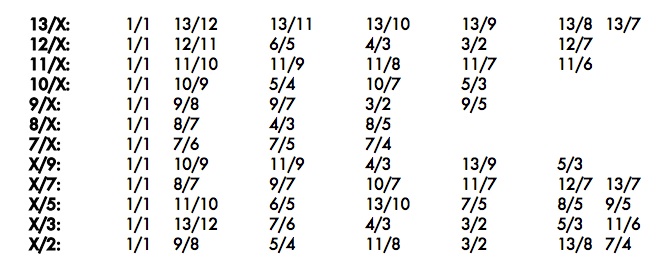
With these intervals better established in my ears I added in 13-related intervals to the kind of harmonic scheme I'd been using.
With my harmonic scale spread more evenly across the octave I began writing pieces pivoting between the harmonics up to the 13th, the 15th, and occasionally a fake 17th harmonic on 15/14, being slightly more exotic than the real 17th harmonic. (The 15/14 root also provided a link to Henry Cowell, the only writer to use this ratio for the just half-step.) One such piece, particularly paradigmatic in my output, is The Unnameable of 2012. In this piece the keyboard solo disappears into the wall of overtones, somewhat like a person walking into a lake, exploring the bottom of it, and then emerging again. Through the bulk of the work the voice-leading approaches immobility. The subjective element is embodied by a motive of a major second - although the major second can variably be 231, 204, 183, 165, or 151 cents in size. It comes to seem like a leap compared to the tiny increments of the contrapuntal background, and yet at every point the motive clarifies the melody's position in the harmonic series of the moment.
I'll play the beginning of the work:
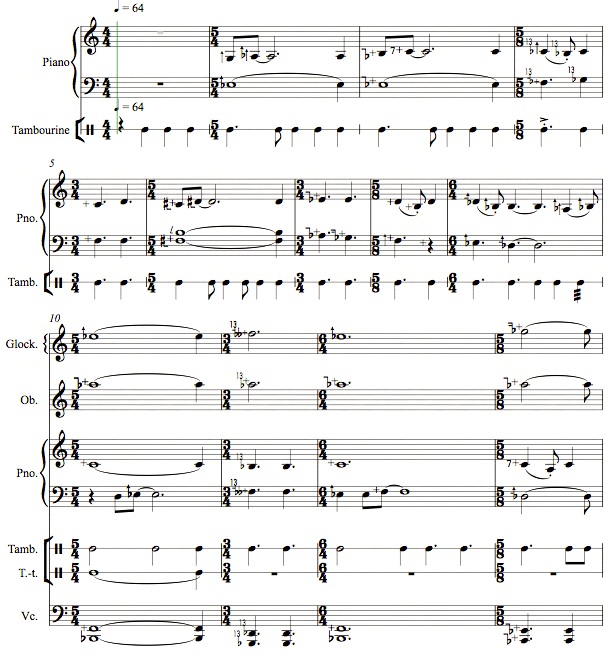
and then I'm going to skip to the densest moment, in which the sense of melodic phrase disappears for a kind of very low-key climax, a climax not of dynamics or texture or register, but merely of harmonic rhythm and disorientation. In this excerpt you can see that the bass notes start on the tonic Bb, then move to the 9th harmonic on C+, the 11th harmonic on E^b, the 13th harmonic on C13b, the 7th harmonic on A7b+, and so on. Melodic movement in the upper parts is as minimal as possible, a kind of virtuoso exhibition of parsimonious voice-leading.
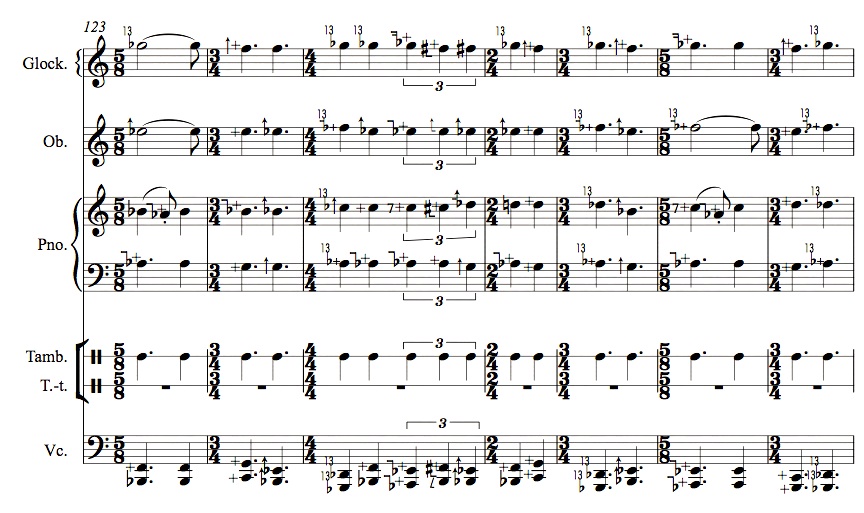
We look next at the different lines in terms of cents above the tonic Bb. The underlined numbers indicate the root of each harmonic series. In the bottom part of the chart, the numbers between lines indicate the pitch movement in cents, showing intervals of 3, 12, 17, 27, 32, with rarely more than 85 cents in the upper voices.
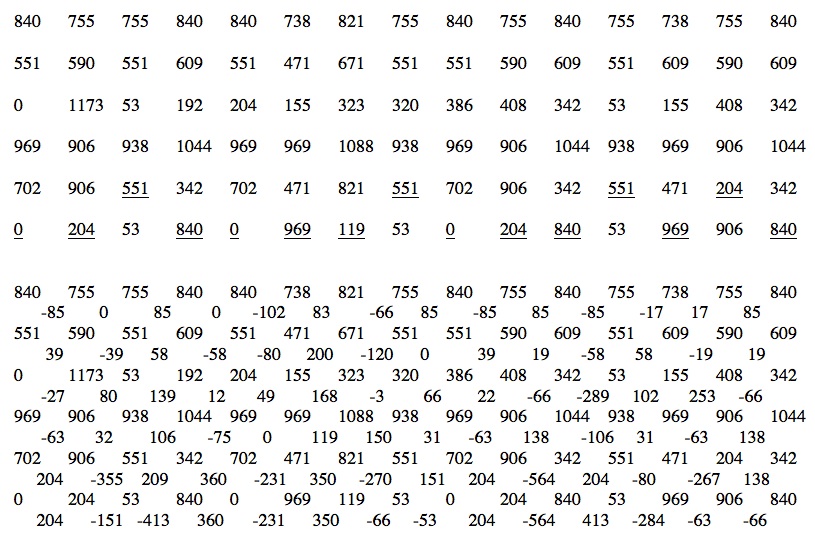
Conceptually, this is no different from the conventional triadic chord progression I played as my first example, except that in addition to the 1st, 3rd, and 5th harmonics I've also added in the 7th, 9th, 11th, 13th, and occasionally 15th, using them similarly as pivot notes to swing to related harmonic areas step by step.
(In the past ten years I've found myself more and more fascinated by barbershop quartet music. Because when you consider it compositionally, barbershop quartet consists of an attempt to keep the 5th, 6th, 7th, 8th, and 9th harmonics continually in play within a two-octave range, shifting fundamentals according to pivot tones, and triggering the sequence of chords by running a melody through it. It hardly matters what the melody is, because the chord sequences come out pretty much the same regardless. What I've demonstrated above is a kind of 13-limit barbershop sextet, complete with melody in the alto. All it needs is for me to write some snappy lyrics for it, buy some boaters and canes, and hit the Appalachian circuit.)
I'm going to play one last example, which is a little tongue-in-cheek piece I wrote in preparation for a much larger piece that I was unable to complete for this conference. The piece is one of a series of little tuning studies I titled Nursery Tunes for Demented Children. This uses an eight by eight grid of harmonics numbers 1 through 15 built on the odd numbered harmonics 1 through 15, a tuning system that I am not the first to use:
The purpose of the little piece, whimsically titled "The Cracked Bells of St. Swithun's," is to demonstrate levels of dissonance and consonance arrived at by simply moving among different triads in the harmonic series. It starts off with triads of 7:9:11 and 10:13:15, replacing them little by little with minor triads of 10:12:15 and major triads of 4:5:6. Once the triads are all major, they begin accruing upper harmonics until each eight-note harmonic series is being played at once. Then notes begin being shed from the top again until we end up with a conventional I6/4-V7 cadence which closes deceptively on a chord on the 13th harmonic. I think of this little piece as partial proof of what I call Henry Cowell's Theory of Relativity, his principle as stated in New Musical Resources that
the points in the [harmonic] series... where consonance leaves off and dissonance begins, are not rigidly fixed... but depend on the ear of the individual listener, who is in turn influenced by the musical age in which he lives... acoustically speaking, there is no point at which any other than an arbitrary difference between them can be shown, which establishes the relativity of consonance, dissonance, and discord. [pp. 10-11]More ambitious pieces I've written in this tuning are Romance Postmoderne, Orbital Resonance, and Futility Row.
Optimism is not characteristic of the times we find ourselves living in, but if it were not for our political situation, I would find boundless optimism for music in the steps of the harmonic series we have not yet assimilated into our music. I have begun learning to hear how chord progressions pivoting on the 11th and 13th harmonics work, but I am a long way from arriving at any kind of idiom or composing habits ready to replace our common practice tonality. Nor have I yet figured out how to work effectively with 7:9:11 and 10:13:15 triads, and so I feel like I might as well be composing in 1605, overwhelmed with possibilities of a vast new language. I also think that in a sense we are closer to the beginning of music's history than its potential end, and that the materials we know about but haven't yet learned how to use effectively could provide enough material for several more centuries of exciting development. And until some totally new direction suggests itself to us, I think that the long past of music, in which we're all so well trained, provides the best available guide to our future.
If you find any of this not clearly enough expressed, e-mail me here
